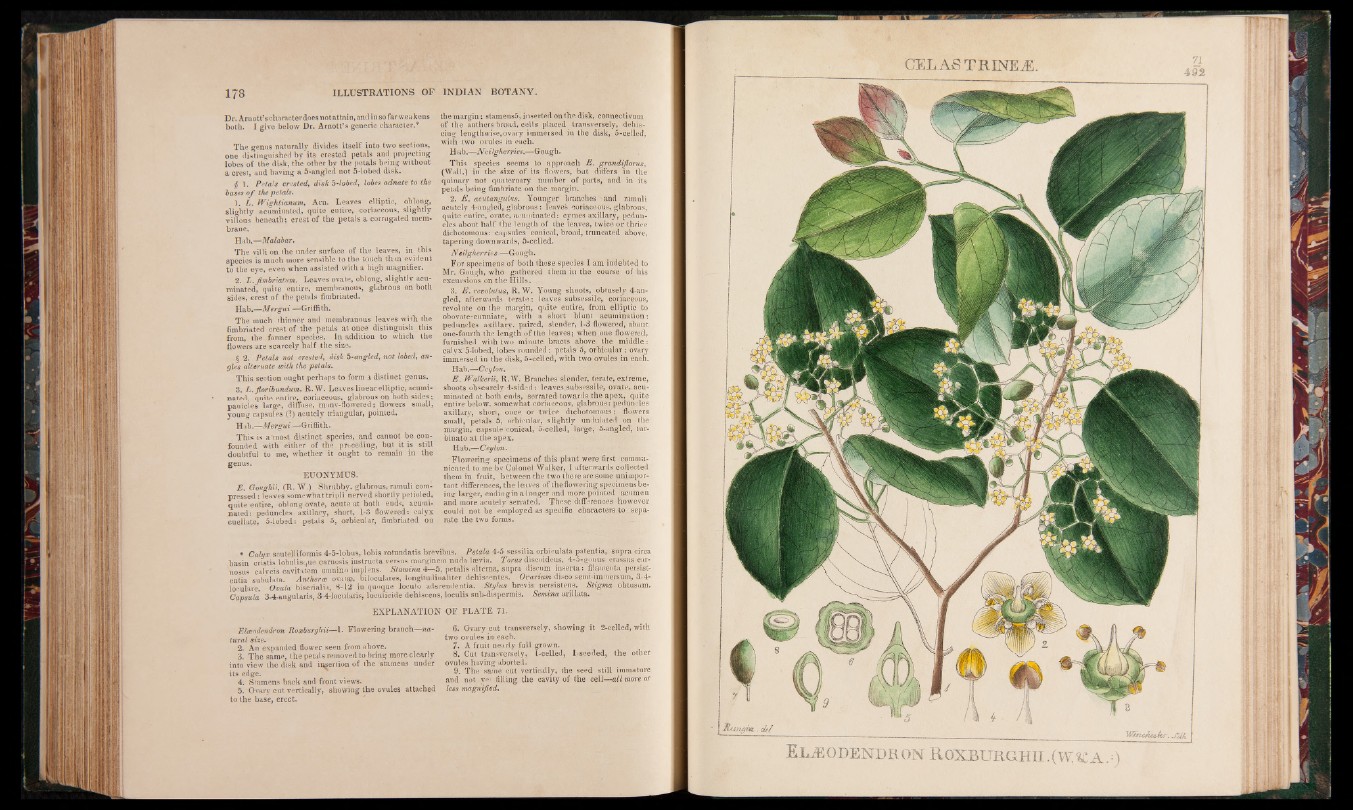
Dr. Arnott’s character does not attain, and in so far weakens
both. I give below Dr. Arnott’s generic character.*
The genus naturally divides itself into two sections,
one distinguished by its crested petals and projecting
lobes of the disk, the other by the petals being without
a crest, and having a 5-angled not 5-lobed disk.
$ 1. Petals crested, disk 5-lobed, lobes adnate to the
bases o f the petals.
1. L. Wightianum, Am. Leaves elliptic, oblong,
slightly acuminated, quite entire, coriaceous, slightly
villous beneath; crest of the petals a corrugated membrane.
Hab.—Malabar.
The villi on the under surface of the leaves, in this
species is much more sensible to the touch thin evident
to the eye, even when assisted with a high magnifier.
2. L . fimbriatum. Leaves ovate, oblong, slightly acuminated,
quite entire, membranous, glabrous on both
sides, crest of the petals fimbriated.
Hab.— Mergui —Griffith.
The much thinner and membranous leaves with the
fimbriated crest of the petals at once distinguish this
from, the former species. In addition to which the
flowers are scarcely half the size.
§ 2. Petals not crested, disk 5-angled, not lobed, angles
alternate with the petals.
This section ought perhaps to form a distinct genus.
3. L. floribundum, R.W. Leaves linear elliptic-, acuminated,
quite entire, coriaceous, glabrous on both sides;
panicles large, diffuse, munv-flowered; flowers small,
young capsules (?) acutely triangular, pointed.
Hab.—Me rgui—Griffith.
This is a'most distinct species, and cannot be confounded
with either of the preceding, but it is still
doubtful to me, Whether it ought to remain in the
genus.
EUONYMTJS.
E. Goughii, (R. W.) Shrubby, glabrous, ramulicom-
pressed: leaves somewhat tripli nerved shortly petioled,
quite entire, oblong ovate, acute at both ends, acuminated:
peduncles axillary, short, 1-3 flowered: calyx
cuellate, 5-lobed: petals 5, orbicular, fimbriated on
the margin: stamens5, inserted on the disk, connectivum
of the anthers broad, cells placed transversely, dehiscing
lengthwise,ovary immersed in the disk, 5-celled,
with two ovules in each.
Hab.—Neilgherries.—Gough.
This species seems to approach E . grandiflorus,
(Wall.) in the size of its flowers, but differs in the
quinary not quaternary number of parts, and in its
petals being fimbriate on the margin.
2. E . acutangulus. Younger branches - and ramuli
acutely 4-angled, glabrous: leaves coriaceous, glabrous,
quite entire, ovate, acuminated: cymes axillary, peduncles
about half the length of the leaves, twice or thrice
dichotomous: capsules conical, broad, truncated above,
tapering downwards, 5-celled.
Neilgherries—Gough.
For specimens of both these species I am indebted to
Mr. Gough, who gathered them in the course of his
excursions on the H ills.
3. E . revolutus, R.W. Young shoots, obtusely 4-angled,
afterwards terate: leaves subsessile, coriaceous,
revolute on the margin, quite entire, from elliptic to
obovate-cunniate, with a short blunt acumination:
peduncles axillary, paired, slender, 1-3 flowered, about
one-fourth the length of the leaves; when one flowered,
furnished with two minute bracts above the middle:
calyx 5-lobed, lobes rounded: petals- 5, orbicular : ovary
immersed in the disk, 5-celled, with two ovules in each.
Hab.—Ceylon.
E . Walkerii, R. W. Branches slender, terate, extreme,
sho_ots_pbscurely 4-sided : leaves.subsessile, 'ovate, acuminated
at both ends; serrated towards the apex, quite
entire below, somewhat coriaceous, glabrous: peduncles
axillary, short, once or twice dichotomous: flowers
small, petals 5, orbicular, slightly undulated on the
margin^ capsule conical, 5-celled, large, 5-angled, tur-
binato at the apex.
Hab.— Ceylon.
Flowering specimens of this plant were first communicated
to me by Colonel Walker, I afterwards collected
them in fruit, between the two there are some unimportant
differences, the leaves of thefloweringspecimensbe-
ing larger, endingin a longer and more pointed acumen
and more acutely serrated. These differences however
could not be employed as specific characters to . separate
the two forms.
* Calyx scutelliformis 4-5-lobus, lobis rotundatis brevibus. Petala 4-5 sessilia orbiculata patentia, supra circa
basin cristis lobulisque carnosis instructa versus marginem nuda lævia. Torus discoideus, 4-5-gonus crassps car-
nosus calvcis cavitate m ornnino implens. Stamina 4—5, petalis alterna, supra discum inserta : filament* persist-
entia subiilata. Antheroe ovatae, biloculares, longitudinal iter déhiscentes. Ovarium disco semi-immersum, 3-4-
loculare. Ovula biserialia, 8-12 in quoque loculo adseendentia. Stylus brevis persistens. Stigma obtusum.
Capsula 3-4-angularis, 3-4-locularis, loculicide dehiscens, loculis sub-dispermis. Semina arillata. -
EXPLANATION OF PLATE 71.
El&odendron Roxburghii—1. Flowering branch—natural
size.
2. An expanded flower seen from above.
3. The same, the petals removed to bring more clearly
into view the disk and insertion of the stamens under
its edge.
4. Stamens back and front views.
5. Ovary cut vertically, showing the ovules attached
to the base, erect.
6. Ovary cut transversely, showing it 2-celled, with
two ovules in each.
7. A fruit nearly full grown.
8. Cut transversely, l-celled, I;-seeded, the other
ovules having aborted.
9. The same cut vertically, the seed still immature
and not vet .filling the cavity of the cell—all more or
less magnified.
C E L A S T R I N E Æ .
71
492
——-----------------— _______________ :______ ____________________ Wtoicà&Mr. JXlh.
E læ o d e n d r o n R o x b u r g h i i . (w % a .:)